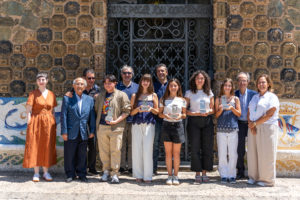September 28, 2022
Modernism is an architectural style that represented the transition between two centuries: from the 19th to the 20th. Its name evokes modernity, change and progress, and was characterized by an urban aesthetic that sought harmony between beauty and functionality.
In Spain, the greatest expression of modernism took place in Catalonia, and, thanks to this, today Barcelona is a unique exponent of modernist architecture: a city where we can enjoy routes that lead us to appreciate every detail of the modernist architectural art.
What does the route of modernism consist of? History and identity of Barcelona
The modernism route in Barcelona is an itinerary through which we can visit its most emblematic modernist style buildings.
Modernism in Catalonia had its origins in 1871, when the architect Elies Rogent i Amat created the Provincial School of Architecture, which would be the cradle of different architects, whose legacy would be reflected in buildings that followed the design modernist
Later, Doménech i Montaner was a pioneer creating architectural works with predominance curves and in which also confluence of Hispanic and Arabic art.
Although the most famous of all modernist architects, and the one that first comes to mind, was Antoni Gaudí, Barcelona’s modernist route has, as if that wasn’t enough, much more to offer: architects such as Josep Puig i Cadafalch, Domènech i Montaner or Salvador Valeri i Pupurull, left us impressive buildings that, as lesser-known gems, are totally worth visiting.
15 modernist works of Barcelona that you should not miss
The modernist route is a journey through Barcelona full of art, beauty and history that you should not miss, do not hesitate, as it is totally worth it. For this reason, in this list we present 15 modernist buildings, curious and less known, that you must visit if you are considering doing it.
Muley Afid House
This building, which is located on Passeig de la Bonanova, was designed by the architect Josep Puig i Cadafalch. It was built in 1914 at the request of the French government with the aim of serving as a residence for the exiled Muley Afid.
The building is characterized by its gardens that keep it isolated, its geometric shapes with white, green and brown colors stand out, as well as the terraces and its pointed tower.
It was restored in 2002 and currently houses the headquarters of the Consulate of Mexico.
Santa María de Valldonzella
The monastery of Santa María de Valldonzella is an imposing neo-Gothic modernist style building. The work of the architect Bernardí Martorell, this spectacular building was built between 1911 and 1922.
The bricks stand out, sharp and brown, as well as the arches and columns distributed in a harmonious arrangement. In addition, from the access door, you can enjoy the beauty of the panoramic views with the sea in the background.
Today, the monastery continues to house the nuns of the Cistercian Order.
Torre Bellesguard
The work of Antoni Gaudí, the Torre Bellesguard, also known as Casa Figueras, is located in a historic place: in 1408 it was the royal residence of the last Count of Barcelona, Martí I l’Humà, and it was also the temporary residence of Benedict XIII, known as Pope Luna.
The building was built mainly between 1900 and 1909 with slate, presenting reliefs in order to accentuate elements that gave it a medieval appearance. Its green, beige and gray colors converge next to a rose on the main facade, known as the “star of Venus”.
The visits to Torre Bellesguard Gaudí are not only worthwhile for its history, beauty and architecture, but also because it is a strategic location, whose panoramic views around Barcelona allow you to leave unique impressions of the city.
Cosmocaixa
In 1909 the architect Josep Domènech i Estapà created this modernist building, which initially functioned as a residence for blind people until 1979. In 2004 it was expanded and remodeled to accommodate its current function: Science Museum of the “La Caixa” Foundation.
It is worth a visit both for its architecture, with its stained-glass windows and brown colors, and for the museum it houses, whose facilities offer exhibitions (temporary and permanent) of great uniqueness: the “Forest” stands out in particular inundated”, a detailed and impressive recreation of the Amazonian ecosystem.
Modernist complex of Sant Pau
The most outstanding work of the architect Lluís Domènech i Montaner, this building was declared a World Heritage Site by UNESCO in 1997 and must be visited if you do the modernism route.
The Hospital de la Santa Creu i Sant Pau began to be built in 1902 thanks to the Barcelona banker Pau Gil i Serra, who to dispose of his inheritance to finance the building, and it was inaugurated in 1930.
The gardens stand out, as it was conceived with the idea that the sick would not feel cloistered, as well as the brown and red colors finished with yellow tones in the upper part.
Col·legi de les Teresianes
Built between 1888 and 1890, this work by Antoni Gaudí was influenced by neo-Gothic aspects, drawing inspiration from medieval architecture.
The building has the shape of a parallelepiped, combining brick with stone, and in 1969 it was declared a historical-artistic monument of National Interest.
Casa Mariano Farriols
In 1914, the architect Alfred Paluzie Lucena built this summer tower that mixed modernist elements with other classics, highlighting the vegetal ornaments on the windows.
Throughout its history it was a private residence, later a school and currently houses a restaurant, which makes it a perfect place to, along your route, regain strength while meeting another exponent of the ‘modernist architecture.
House of Spirituality Sant Felip Neri
This house of spirituality, owned by the Congregation of Filipino Religious, contains a remarkable modernist tower that was built in the 19th century.
Located in the Tres Torres district and dedicated to meditation, it is surrounded by gardens of imposing beauty.
Casa Comalat
It was built in 1911 by the architect Salvador Valeri i Pupurull thanks to the patronage of the textile industrialist Joan Comalat Aleñá.
Experts in modernist architecture have described Casa Comalat as a unique work in the entire city of Barcelona. Its facade has two large balconies on the sides and a rich and striking decoration with colors that are enhanced in the sunlight and in which green stands out. The building is currently a private property.
Els 4 Cats
Originally a brewery where followers of bohemian life met between the end of the 19th century and the beginning of the 20th, the architect behind this modernist building erected in 1897 was Josep Puig i Cadafalch.
Art and literature exhibitions to puppet or musical shows were held in this place. Celebrities such as Antoni Gaudí, Lluís Millet, Enrique Granados or Pablo Picasso himself passed through it.
Nowadays it has returned to function as a restaurant, maintaining the period decoration, which makes it a unique visit that you should not miss.
Casa de les Punxes (House of Spikes)
This modernist work, located on Avinguda Diagonal in Barcelona, is made up of a multi-storey building that imitates medieval castles.
The work of the architect Josep Puig i Cadafalch, this building was built in 1905 and stands out for its triangular plan and its crowning with six pointed towers in reddish colors, which give it the name “Casa dels Punxes”.
Without a doubt, it is one of the most emblematic modernist buildings in the city, which will not leave anyone indifferent.
Casa Roviralta
Casa Roviralta was built between 1903 and 1913 and is the work of the architect Joan Rubió i Bellver. It is a modernist building located at number 31 of Avinguda del Tibidabo.
The facade is an exceptional example of modernist architecture, in which the contrast between the white color and the ceramic colored bricks is emphasized. Today the building is a restaurant.
Casa Pàdua
In 1903, this modernist style house was built by the architect Jeroni Granell i Manresa.
Although we have no information about which family inhabited it, we do know that it was originally a residence of some Catalan bourgeois family, and was later used as a perfume factory.
Its facade stands out, with exceptional beauty through a decoration of plant shapes that plays with the contrasts between red and white colors.
Torre Amdreu
Torre Andreu, also known as the Rotonda, is located on the corner of Paseo de Sant Gervasi and Avinguda del Tibidabo.
It was completed in 1918, as the work of the modernist architect Adolf Ruiz i Casamitjana and was originally a hotel: the Hotel Metropolitan. During the sixties, celebrities such as Alfredo Kraus, Rock Hudson and Baroness Thyssen passed through this modernist building. From the 1970s, the building became a hospital.
The most outstanding element of this architectural work is, without a doubt, the oriental pagoda that crowns the tower.
Portal Mirralles
It was built between 1901 and 1902 by the architect Antoni Gaudí, forming the entrance to Casa Miralles.
Although it was a minor work, it allows us to observe first-hand how the modernist elements materialized in architecture, with Gaudí’s characteristic undulating styles and with a wrought iron cross crowning it.




